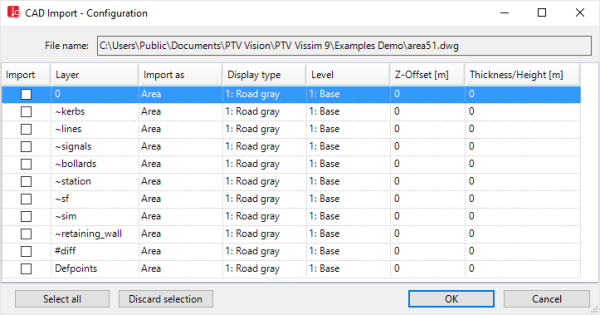
Notes: In the *.dwg file, the x- and y-coordinates must be specified in meters.
During import of the *.dwg file, z-coordinates are ignored.
You can import AutoCAD data into Viswalk. Using AutoCAD data, you can create walkable areas and obstacles for pedestrians.
With the help of maps of the area, you create the geometry required for pedestrian flow simulation.
To complete an existing network or create a new one, import polylines in the data format *.dwg and convert them.
Depending on the parameter settings you select for data import, all objects of an AutoCAD layer are converted into areas or obstacles.
|
|
Notes: In the *.dwg file, the x- and y-coordinates must be specified in meters. During import of the *.dwg file, z-coordinates are ignored. |
1. From the File menu, choose > Import > CAD for Pedestrian Areas.
The Import CAD File window opens.
2. Select the *.dwg file of your choice.
3. Click the Open button.
The CAD Import - Configuration window opens. A level is displayed for each row.

4. In the columns, select the attributes of your choice.
|
Column |
Description |
|---|---|
|
Import |
|
|
Layer |
Name of the CAD level from the *.dwg file |
|
Import as |
Network object type for the level:
|
|
Display type |
Select the Display type Display types have to be defined (Defining display types). |
|
Level |
Select Level from Vissim for the CAD levels from the *.dwg file. The level has to be defined in Vissim (Defining levels). |
|
Z-Offset top/bottom |
Offset above: Positive value for the distance between the ground and the top edge of the area or the obstacle. Offset below: Negative value for the distance between the ground and the bottom edge of the area or the obstacle. |
|
Thickness/Height |
|
| Select all | In the Import column, selects all layers from the *.dwg file for import. |
| Deselect all |
Deselects all selected options in the Import column. |
|
|
Notes: The unit used in the window for all lengths corresponds to the unit of length for the smallest unit of length selected, for example [m]. Check this setting before import in the menu Base data > Network settings > Units tab. |
5. Confirm with OK.
The CAD Import - Configuration window closes.
The imported polygons are displayed as construction elements in the network editor and in lists. You can edit or delete the construction elements.
Superordinate topic:
Modeling construction elements
Related topics:
Attributes of ramps and stairs, moving walkways and escalators
